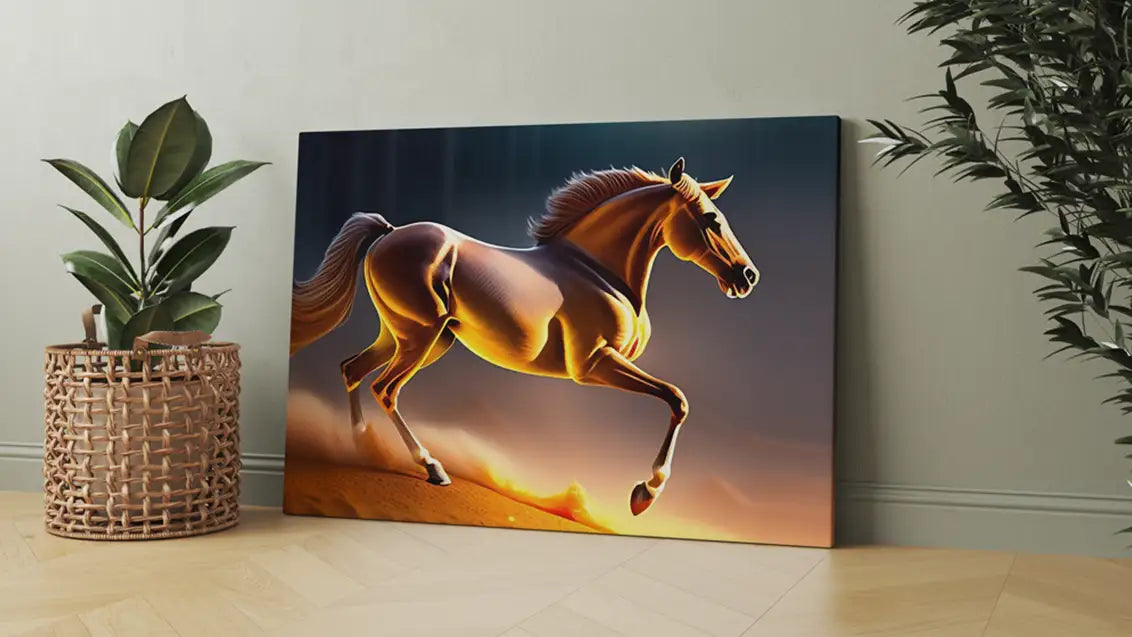
Picking the Right Medium for Your Pet Canvas Art: Watercolor or Oil?
Pet canvas art, an artistic journey that holds a special place in the hearts of pet guardians. It serves both as a testament and homage to the infinite love we share with our furry bundle of joy, allowing us to capture their essence in a timeless form. However one important decision lies ahead before embarking on this artistic voyage: selecting the ideal medium by which to bring your vision to life. Which medium should you choose? Watercolor or oil… Your choice of medium will influence the final outcome, shaping the character of the artwork. In this exploration, we'll navigate the world of pet canvas art, shedding light on the qualities of watercolor and oil, and helping you make the right choice for your furry muse.
So, whether you want the soft touch of watercolor or the richness of oil, join us in this artistic voyage to discover which medium best captures the spirit of your four-legged companion. It's time to embark on a creative odyssey where the stroke of a brush brings your pet's personality to life on canvas.
Watercolor - A Medium For Pet Canvas Art
Watercolor, a painting approach characterized by way of the harmonious suspension of pigments in a water-primarily based solution, has long captivated artists with its exceptional translucency and radiant luminosity. With each brushstroke delicately carried out in your canvas pet portraits keepsake, this charming medium unfurls a world of ethereal beauty that transcends reality.
Advantages of Watercolor for Pet Portraits
Watercolor painting is highly effective in depicting the interplay of light and shadow, resulting in a soft and luminous depiction of your pet's fur on canvas. The flowing properties of watercolors lend themselves well to gentle blending techniques, which are perfect for capturing the intricate textures and nuances present in your pet's coat. Here are some more advantages of using watercolor for pet portraits:

- Expressive and Vibrant: Watercolors are known for their vivid and expressive qualities. They can capture the personality and essence of a pet, bringing out their character and vibrancy in the artwork.
- Transparency and Layering: Watercolors allow artists to build up layers of color, creating depth and dimension in the painting. This layering technique is perfect for achieving realistic fur textures and shading.
- Timelessness: Watercolor pet portraits have a timeless and classic appeal. They evoke a sense of nostalgia and are a cherished way to commemorate a beloved pet.
- Non-Toxic and Safe: Watercolor paints are generally non-toxic and safe for artists to use. This is important, especially if the artwork is being created as a keepsake for a pet owner.
- Portable and Clean: Watercolor painting requires minimal setup and is a clean and portable medium. This makes it convenient for artists to work on pet portraits wherever inspiration strikes.
Considerations
- Layering: Watercolor is a transparent medium that relies on layering. Start with light washes and gradually build up color and detail. This approach helps create depth and texture in the fur and eyes.
- Patience: Watercolor is a medium that demands patience. Allow each layer to dry before adding the next. Rushing can lead to muddy or unintended color mixing.
- Control of Water: Controlling the amount of water you use is vital. Too much water can dilute the colors or cause paper warping. Conversely, too little water can lead to difficulty in blending.
- Blending Techniques: Watercolor artists often use techniques like wet-on-wet and wet-on-dry to create various effects. Wet-on-wet involves applying paint to a wet surface, while wet-on-dry involves applying paint to a dry surface. Experiment with both techniques to achieve different results.
- Correction and Lifting: Watercolors can be forgiving. You can lift color with a clean, damp brush or a blotting paper if you make a mistake. However, avoid excessive scrubbing, as it can damage the paper surface.
Embracing Oil for Pet Canvas Art
Oil painting is a captivating artistic technique that involves skillfully blending pigments with oil-based mediums. This meticulous process results in the creation of exquisite, dynamic colors embellished with an appealingly gradual drying time. One of the distinguishing features that sets oil painting apart from other methods is its ability to convey depth and texture effortlessly, bringing the custom pet canvas to life in ways that truly captivate viewers.
Advantages of Oil for Pet Portraits
Oil paints provide a diverse selection of vibrant and rich colors that are well-suited for capturing the distinct attributes of your beloved pet and landscape painting backgrounds. The extended drying period allows for seamless blending and layering techniques, allowing you to create intricate fur textures and realistic details. Here are some more of the advantages of using oil paints for pet portraits:

- Rich and Vibrant Colors: Oil paints are known for their intense and vibrant colors. This allows artists to capture the depth and warmth of a pet's fur, eyes, and features with exceptional richness.
- Detail and Realism: The slow drying time of oil paints allows for intricate details and precision. Artists can capture the fine details of a pet's features, including whiskers, fur patterns, and the sparkle in their eyes.
- Texture and Impasto: Oil paints can be applied in various ways, including impasto techniques, where paint is applied thickly. This allows artists to create tactile textures that mimic the feel of fur or feathers.
- Versatility: Oil paints can be used on a variety of surfaces, including canvas, wood, and even paper. This versatility allows artists to choose the medium that best suits their style and preferences.
- Classic and Timeless: Oil paintings have a classic and timeless appeal. They evoke a sense of tradition and artistry, making them a beautiful way to commemorate a beloved pet.
Considerations
Crafting pet portraits using oil paints is an enriching pursuit, yet it entails certain factors that artists should bear in mind. Here are crucial aspects to contemplate when employing oil paints for pet portraits:
- Toxicity: Some oil paint pigments can be toxic if ingested or absorbed through the skin. Take care to avoid direct contact with the paint and use protective gear like gloves if necessary. Clean your brushes and tools with a safe solvent.
- Ventilation: Oil paints use solvents and mediums that can produce fumes. Ensure you work in a well-ventilated area or use a suitable ventilation system to maintain a safe and comfortable workspace.
- Drying Time: Oil paints have a slow drying time, which can be an advantage for blending and layering but also requires patience. Be prepared to work on your portrait over multiple sessions to allow for drying between layers.
How to make the right choice for custom pet canvas - watercolor or oil?
1. Artistic Preference
Your individual artistic style and preferences play a pivotal role in your decision making process. Taking into consideration whether you have an inclination towards the soft, delicate aesthetics of watercolor or the strikingly textured sensations offered by oil painting can greatly assist in guiding your choice for pet portrait canvas.
2. Style and Intended Effect
When considering the style you want to convey in your pet portrait canvas, it is important to think about how different mediums can achieve different effects. Watercolor tends to excel in portraying a light and airy atmosphere, while oil painting has the ability to capture the depth and complexity of fur. Both mediums have their own unique characteristics that allow for various artistic expressions.
3. Check Illustration
To gain a deeper understanding of the unique characteristics and possibilities offered by watercolor and oil painting, it is beneficial to examine examples of pet canvas art created using both mediums. This exploration of pets on canvas painting can provide valuable insights into the distinct expressive qualities each medium possesses.
4. Seek guidance
Consulting with experienced artists who have expertise in creating both watercolor and oil pet portraits on canvas can provide invaluable insight, tips, and guidance based on their own rich experiences in the field. These seasoned professionals are well-equipped to offer valuable advice on how to effectively capture the unique characteristics of our beloved pets using different painting mediums. Their firsthand knowledge can greatly enhance our artistic endeavors and assist us in achieving remarkable results.
Summing Up
As we draw our exploration to a close, the choice ultimately resides in your heart, your artistic vision, and your connection with your pet. Watercolor unveils the gentle, ethereal qualities of your pet's presence. On the other hand, oil painting delves into the richness and depth of your pet's character. In the end, whether you choose the luminosity of watercolor or the depth of oil, the true essence of pet canvas art lies in the love and connection you share with your animal companion. Every brushstroke is an expression of that bond, every color a reflection of your pet's unique personality.
So, embrace the artistic journey with Pets by numbers, and let your heart guide your hand. For in the world of pet canvas art, it's not just about the medium; it's about the love and devotion you pour onto the canvas, immortalizing your pet's spirit for all time. Your choice is a brushstroke in the masterpiece of your pet's life story, and whichever path you take, it's a testament to the enduring bond you share.

